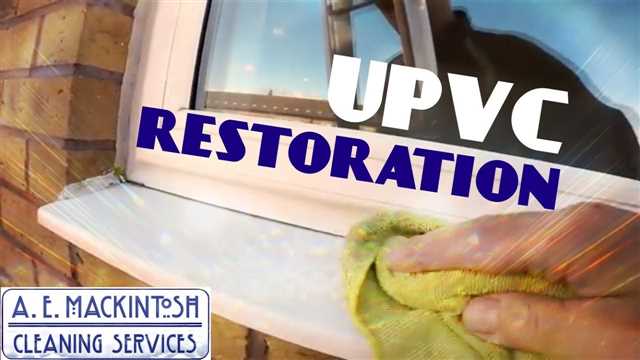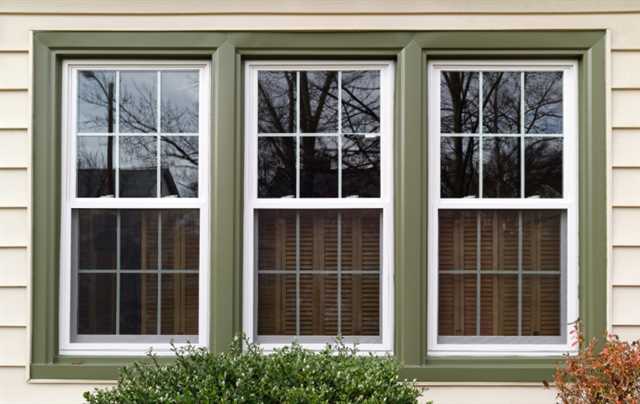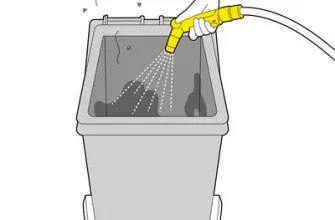
When it comes to spring cleaning your home, don’t forget about your windows! uPVC windows are a popular choice for many homeowners due to their low maintenance and durability. However, over time, they can still gather dirt and grime that needs to be cleaned. In this guide, we will show you the best tips and tricks for getting your uPVC windows looking their best this spring.
First things first, gather all the necessary cleaning supplies. You will need a soapy water solution, uPVC cleaner, glass cleaner, a sponge, a soft cloth, and some kitchen roll or newspaper. Don’t forget to also have a vacuum cleaner on hand to remove any dust or cobwebs from the frames.
Start by vacuuming the frames and sills to remove any loose dirt and debris. Then, using the soapy water solution, wipe down the frames and sills with a sponge. For stubborn stains or marks, you can use a uPVC cleaner to help remove them. Be sure to follow the instructions on the cleaner and test it on a small, inconspicuous area first to ensure it doesn’t damage the uPVC.
Next, move on to the glass. Spray the glass cleaner across the surface and use a soft cloth to wipe it clean. To avoid streaks, it’s best to wipe in a circular motion or use a squeegee. For any stubborn marks, you can use a mixture of white vinegar and water or a glass cleaner specifically designed to remove streaks.
If your uPVC windows have varnish or paint on them, you may need to use a varnish or paint remover to remove it. Again, be sure to follow the instructions carefully and test it on a small area first.
When cleaning the exterior of your uPVC windows, you might need to use a ladder or extendable brush to reach the higher areas. Be sure to take all necessary safety precautions and have someone with you for assistance if needed.
Finally, don’t forget about the little details. Use a cotton bud or a soft cloth to clean the corners and edges of the windows. And don’t overlook the window tracks – use a damp cloth or sponge to wipe them clean.
By following these tips and avoiding common cleaning mistakes, you can keep your uPVC windows looking their best all year round. So roll up your sleeves, put on some cleaning music, and get ready to make your windows sparkle!
- Here are some top tips for cleaning your uPVC windows:
- Why is Spring Cleaning Important for uPVC Windows?
- Step-by-Step Guide to Spring Cleaning your uPVC Windows
- 1. Gather your supplies
- 2. Start by removing dirt and debris
- 3. Mix your cleaning solution
- 4. Clean the window frames
- 5. Wash the windows
- 6. Focus on the stubborn stains
- 7. Pay attention to the window hardware
- 8. Finishing touches
- Tips for Maintaining the Appearance of uPVC Windows
- Can you clean uPVC with white spirits?
- Video:
- The Secret Caulking Tip That Will Transform Your Ability!
Here are some top tips for cleaning your uPVC windows:
– Use a soapy water solution or a uPVC cleaner to wipe down the frames and sills
– Use a glass cleaner and a soft cloth to clean the glass
– Avoid using bleach or abrasive products on your uPVC windows, as they can cause damage
– Wipe in a circular motion or use a squeegee to avoid streaks on the glass
– Test any cleaning products on a small area first to ensure they’re safe to use
– Clean the corners, edges, and window tracks thoroughly
– For exterior cleaning, use a ladder or extendable brush to reach higher areas
– Don’t forget about the little details – cotton buds or soft cloths work well for these
– Keep safety in mind when cleaning the exterior of your windows
– Enjoy the satisfaction of sparkling, clean windows!
With these tips and tricks, your uPVC windows will be shining like new in no time. Happy cleaning!
Why is Spring Cleaning Important for uPVC Windows?
Spring cleaning is an essential task to maintain the cleanliness and durability of uPVC windows. It helps to remove dirt, dust, grime, and any build-up that may have accumulated during the winter months. By keeping your uPVC windows clean, you can ensure that they stay looking their best and even extend their lifespan.
Here’s why spring cleaning your uPVC windows is crucial:
- Prevent damage: Cleaning your uPVC windows regularly can help prevent potential damage. Dirt and debris can cause scratches or stains on the window frames, while moisture build-up may lead to mold or mildew growth. By cleaning and inspecting your windows, you can identify any issues early and address them before they worsen.
- Maintain a white and spotless finish: uPVC windows are known for their white and clean appearance. Regular cleaning can help maintain this fresh look by removing any dirt or stains that may have accumulated over time.
- Avoid streaks and marks: When uPVC windows are not cleaned properly, streaks and marks can be left behind. By using the correct cleaning solutions and techniques, you can achieve a streak-free finish and ensure that your windows look pristine.
- Enhance the exterior appearance: Clean uPVC windows can significantly improve the overall appearance of your home. As the windows are one of the first things people notice, ensuring they are thoroughly cleaned will make a positive impression.
- Extend the lifespan: uPVC windows are durable, but proper maintenance is essential to ensure their longevity. Regular cleaning helps to remove any contaminants that could potentially cause damage to the frames, glass, or hardware.
To properly clean your uPVC windows, you’ll need some basic supplies, such as warm soapy water, vinegar, a bucket, a sponge or cloth, a squeegee, and newspaper. Avoid using harsh chemicals or abrasive cleaners that can damage the uPVC material.
Here are some top tips for cleaning your uPVC windows:
- Start by sweeping away any loose dirt or debris from the window frame and sill.
- Prepare a mixture of warm soapy water or a vinegar solution for cleaning.
- Dip the sponge or cloth into the cleaning solution and scrub the window frames and glass thoroughly.
- Use a squeegee or a cloth to wipe away the excess water and cleaning solution.
- If there are any stubborn stains or marks, you can use a uPVC cleaner or a vinegar solution to remove them.
- Dry the windows with a clean, lint-free cloth or newspaper to avoid streaks.
- For hard-to-reach areas, use a sturdy ladder or an extension pole to clean the upper parts of the window frame.
- If you encounter any paint splatters, adhesive residue, or other tough stains, consider using a uPVC cleaner or a suitable solvent-based remover.
- Regularly vacuum the window tracks and seals to remove any dirt or debris that may affect their functionality.
- Following cleaning, you can also apply a uPVC protective solution or cream to keep your windows looking their best.
By following these cleaning tips and regularly maintaining your uPVC windows, you can ensure they continue to enhance the appearance and functionality of your home.
Step-by-Step Guide to Spring Cleaning your uPVC Windows

1. Gather your supplies
To clean your uPVC windows, you will need the following supplies:
- A ladder (if needed)
- A bucket
- Warm, soapy water
- A sponge or cloth
- A soft-bristle brush
- A squeegee or lint-free cloth
- A uPVC cleaner or a solution of vinegar and water
- Clean, dry towels
2. Start by removing dirt and debris

Before applying any cleaner, it is important to remove loose dirt and debris from your windows. Use a soft brush or a dry cloth to sweep away any dust, cobwebs, or leaves that may have accumulated on the exterior of your windows and frames.
3. Mix your cleaning solution
In a bucket, mix warm water with a uPVC cleaner or a solution of vinegar and water. Avoid using abrasive or harsh chemical cleaners, as they can damage your uPVC windows.
4. Clean the window frames
Dip a sponge or cloth into the cleaning solution and gently scrub the uPVC window frames. Pay special attention to dirty or stained areas. Rinse the frames with clean water and wipe them dry with a clean cloth or towel.
5. Wash the windows
Dip a sponge or cloth into the cleaning solution and thoroughly wash the glass windows. Make sure to remove any stains or marks. Use a squeegee or a lint-free cloth to remove excess moisture from the windows. Start from the top and work your way down, using horizontal strokes to avoid streaks.
6. Focus on the stubborn stains
If there are any stubborn stains on your windows, you can use a uPVC cleaner or a mild liquid solution designed for stain removal. Apply a small amount of the cleaner on a cloth or sponge and gently scrub the stained area. Rinse with clean water and dry with a towel.
7. Pay attention to the window hardware
Don’t forget to clean the handles, hinges, and locks of your uPVC windows. Use a cloth or brush dipped in the cleaning solution to remove dirt and grime. Dry them thoroughly to avoid water spots.
8. Finishing touches
Once you have finished cleaning the windows, take a step back and inspect them for any missed spots or streaks. If needed, go back and touch up any areas that require additional cleaning.
Remember, regular cleaning and maintenance will help keep your uPVC windows looking fresh and sparkling for years to come.
Tips for Maintaining the Appearance of uPVC Windows

- Clean regularly: Regular maintenance is key to keeping your uPVC windows looking fresh and white. Make sure to clean them at least once every spring.
- Avoid using harsh cleaners: While uPVC is a durable material, harsh cleaners can damage the surface of your windows. Instead, opt for mild soap and water or a specialized uPVC cleaner, depending on the level of dirt and grime.
- Focus on frames and sills: When cleaning your uPVC windows, don’t forget to pay attention to the frames and sills. Use a soft cloth or sponge to remove any dust, dirt, or cobwebs that may have built up.
- Use vinegar for tough stains: If you’re dealing with stubborn stains or hard water marks, mix equal parts white vinegar and water in a spray bottle. Spray the solution onto the stained areas and let it sit for a few minutes before wiping it away.
- Avoid using bleach: Bleach may seem like a powerful cleaner, but it can actually cause damage to your uPVC windows. Avoid using bleach or any other abrasive cleaners that contain bleach.
- Opt for newspaper or a squeegee: To achieve a streak-free finish when cleaning the glass of your uPVC windows, use a squeegee or newspaper. These materials help to remove dirt and grime without leaving any residue behind.
- Remember the window backs: Many people overlook the backside of their windows when cleaning. Make sure to clean both sides of the windows to maintain their appearance.
- Be careful with varnish and paint: When refreshing the appearance of your uPVC windows, be cautious when using varnish or paint. Improper application can lead to damage or discoloration.
- Don’t forget the little things: Pay attention to the small details when cleaning your uPVC windows, such as hinges, locks, and handles. These areas can accumulate dirt and grime over time and should be cleaned regularly.
By following these tips, you can keep your uPVC windows looking fresh and maintain their appearance for years to come.
Can you clean uPVC with white spirits?
When it comes to cleaning your uPVC windows and doors, you may wonder if you can use white spirits. White spirits, also known as mineral spirits, are a type of solvent commonly used for thinning paint and cleaning brushes. While they can be effective at removing tough stains, using them on uPVC may not be the best idea.
White spirits are strong solvents that can potentially cause damage to your uPVC window frames. The harsh chemicals in white spirits can strip away the protective coating on the uPVC, leaving it vulnerable to fading, discoloration, and even cracks. Additionally, the fumes from white spirits can be harmful if inhaled, so it’s important to use them in a well-ventilated area.
Instead of using white spirits, there are other cleaning solutions that are more suitable for uPVC. Here are a few tips to help you clean your uPVC windows and doors effectively:
- Start by sweeping away any dirt or debris from the window frame using a brush.
- Mix a solution of warm water and a mild detergent, such as washing-up liquid, in a bucket.
- Dip a soft cloth or sponge into the soapy water and wipe the uPVC frame, paying special attention to any dirty or stained areas.
- If there are stubborn stains or marks on the uPVC, you can use a uPVC cleaner or a gentle bleach solution. Make sure to follow the manufacturer’s instructions and test the solution on a small, inconspicuous area first.
- After cleaning, rinse the uPVC frame with clean water to remove any residue.
- Dry the uPVC thoroughly with a clean, lint-free cloth.
Remember to avoid using abrasive cleaners, such as scouring pads or harsh chemicals, as they can scratch or damage the uPVC surface.
By following these tips, you can keep your uPVC windows and doors looking fresh and clean for longer. Spring cleaning doesn’t have to be a daunting task when you know the right techniques and solutions to use.








